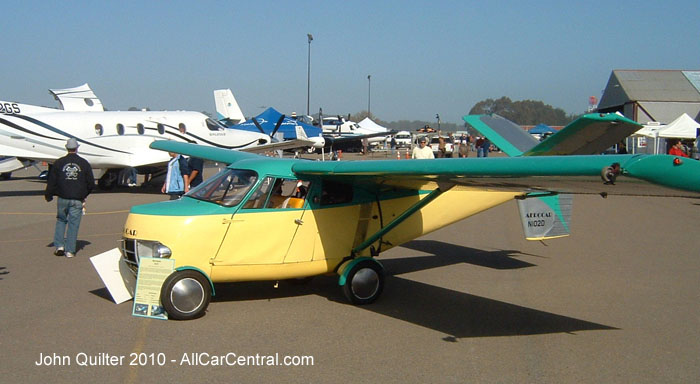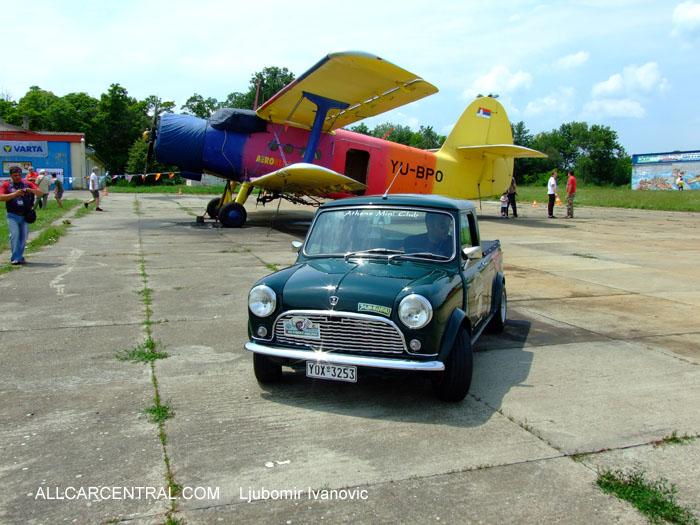Wolseley to Aircraft by Geoff Wheatley
Wolseley to Aircraft by Geoff Wheatley Photos and Stories.
Wolseley to Aircraft by Geoff Wheatley
Wolseley to Aircraft
Miscellaneous:


John Quilter Photo 2010
Today the forecast for the future of private transport is self drive cars; eighty years ago it was an airplane in every garage. The success of such aircraft as the De Havilland Moth that sold for under a thousand dollars in 1926 and required limited service, started the idea that flight was the future, means of private transport. The aircraft was simple to fly and easy to maneuver, in fact you could buy a trailer to hitch on the rear of your family motor car for around sixty dollars complete with lights and breaks. In the USA there were similar aircraft companies producing inexpensive light aircraft for sale to the general public The vehicle manufacturers on both sides of the Atlantic saw a potential for expanded sales through the manufacture of simple but reliable engines to power this new consumer demand. By 1930 there were no less than ten engine manufacturers in the UK, five in France, six in Italy and three in Germany despite the fact that in Germany, such production had been banned at the end of the First World War by the allies.
In the US it was eleven, which may seem low compared with the size of the USA but the whole aircraft industry was severely affected by the Depression that started in the USA, and unlike the UK and France did not get any financial support from the government of the day. The idea that light aircraft would be a universal product like the car or truck was stimulated by people like Linburg …. Who flew solo from the US to Paris and an English girl named Amy Johnson who flew solo from London to Australia in twenty days in a De-Havilland Gipsy Moth that had cost eight hundred and sixty two US dollars, NEW. Even the Prince of Wales had his own DH Moth that he often flew to locations in Europe, much to the concern of his father King George and the Prime Minister. The first real PR exercise in the future of flight was in 1919 when two British RAF pilots flew from Newfoundland Canada, to Ireland, ending up in an Irish bog where they landed. The flight in a twin engine British “WW One”, bomber took seventeen hours with each taking turns to crawl out on the wings to scrape off the ice.

Ljubomir Ivanović Photo
The Wolseley Motor Company had built aero engines during the First World War; all radial of course which were the most popular at that time. Popular because they did not require any special cooling equipment, always a serious problem with the standard straight block design as the Germans found out in the early days of the war until they obtained a French airplane that had an enclosed liquid cooling system developed in 1915. When the Morris Company purchased Wolseley Motors in 1919 Billy saw the potential for the sale of light aircraft in the post war years and financially supported the engine program. Being the largest engine manufacturer in Europe he did have something of an advantage, while the fact that he was also a good financial risk for investment brokers helped the situations. BY 1926 Morris Cowley was producing over a thousand cars and light vans a week, higher that Ford Europe, Fiat Motor Company and Renault put together. In 1930 the Wolseley Aircraft Development division produced a rotary cylinder aero engine that the Royal Air Force showed interest in utilizing. That same year Morris announced at a Shareholders Meeting that the company intended to manufacture aero engines in the Wolseley production facility. Looking at the poor sales of the Wolseley Motor Division this was a much needed boost to the company. The demand for semi luxury motor vehicles was at best limited and Wolseley had only catered to this market until the depression hit sales. In short, The Depression was showing its effect on the vehicle market and value for money with no fancy trim was a prime driving force throughout the industry.
_Model_Y_1934__Rick_Feibusch-2008.jpg)
Ford Model Y; Photo Submitted by Rick Feibusch
In 1931 you could buy a UK manufactured family Ford for three hundred US dollars, while a Morris Motors Cowley model was fifty dollars less.. Austin Motors were offering the Austin Seven for two hundred with a spare wheel!
In the US a four door family vehicle had an average price of under three hundred and fifty dollars with Ford USA leading the way with a family sedan at two hundred and eighty five, including spare wheel and a tool kit. Not far behind was Chevrolet with a price range starting at three hundred and forty with a Superior Sedan priced at four hundred and thirty. Chevrolet a division of General Motors had always seen Ford as its principle rival, but Ford had the advantage of overseas production and sales, especially in the U.K.
In 1926 Morris Motors launched a monthly publication for existing and potential Morris owners entitled of course THE MORRIS OWNER. It proved to be quite a success and was read by a large audience of vehicle owners. It was often quoted by the national media in various reviews of the Motor Industry. In 1930 it published a feature encouraging the readers to purchase a light aircraft with information on the estimated cost for such a purchase including maintenance costs. The estimate was based on flying 12,000 miles a year and included storage of the aircraft when not in use. The estimated figure was two hundred and fifty dollars a year which related to a cost around six cents a mile. The smart owner would often join a local aero club and get free use of storage when required. The government of the day not only encouraged these clubs but also gave certain financial help especially as far as actual flying was concerned and a subsidy on fuel purchase. The reason was simple, with the threat of another war on the horizon it was an inexpensive way to train new pilots who could be drafted as and when required. From the Wolseley aspect every new plane sold with their engine was a profit to the company or rather Morris Motors who controlled the whole Wolseley operation. Morris invested about five hundred thousand dollars of his own money into the program convinced that the engines would be accepted by the Air Force as Britain rearmed.
It has been suggested that Morris was a secret admirer of flying hence his interest in the Aero Radial Engine. I think this is simply wishful thinking by certain people. He never took a scheduled air craft flight even after the war when such things were becoming a normal means of travel. He did have a private plane that was used by senior employees of the Morris Empire named Miss Wolseley simply because it featured two Wolseley aero engines. He did use this aircraft to visit various UK locations but that was about the limit of his air travel...Luxury sea travel was more his choice and I suspect Lady Nuffield who certainly enjoyed her status and position. For Billy it was simply a financial investment and he had been more than successful in that field. He was persuaded to invest in the production of an aircraft aptly named the Airspeed Oxford that featured two Wolseley radial engines. The Air Ministry were interested in purchasing a number of these planes as training aircraft so the future looked reasonably secure for Wolsley aero engine production One of the designers of this aircraft was a young aero engineer named NEVIL SHUTE, better known in the post war years as a successful writer. By 1937 the future looked bright for the Wolseley Aero division with orders on file for a total of thirty Airspeed Oxford planes fitted with Wolseley engines ordered by the Air Ministry.
There was a spin off for MG Abingdon through this contract as certain parts of the Wolseley Aero engine would be produced at the MG factory. This was important to MG as their venture into the large luxury market with the VA Series had not been a success and the so-called new MGTA series was a total disaster with the family Morris engine as its power source. The MGV series was not able to compete with the Jaguar vehicles designed for the same limited market at cheaper prices.
The agreement for Morris Motors to be part of the shadow Factory operation had been signed by Lenard Lord while Morris was on a world cruise. On his return he made it quite clear that he was not going to have some civil service individual running any part of his companies including the Aero Engine production. This did not go down very well in government circles and in consequence the Air Ministry canceled their order for thirty aircraft from Wolseley Aero Ltd. This attitude within the Morris Empire led to the departure of Lenard Lord who went on to become the CEO of Austin Motors and in the long term to the sacking of Kimber. The situation was further enhanced, not for the better of course, by the refusal on the part of Lord Morris to supply the air ministry with the newly developed Wolseley Aero Engine. Despite the fact that a contract had been agreed on for a production run of fifty units. There can be little doubt that this decision cost Morris a considerable amount of money, in reality his own money that had been invested for the development of the Wolseley aero engines.
Even when the war started the Morris Empire did not get much in the way of War Contracts until it became obvious that their production ability was required in the war effort. In his post war biography Morris admitted that it had been a mistake to take on the government in an argument that even the great Billy could not win. On top of that he was more than aware of the financial costs in taking such action. It went further, When the post war government decided to create the British Motor Corporation combining the Austin Corporation with the Morris Empire Billy thought that one of his chosen directors would be selected as the CEO of the new and powerful BMC backed with taxpayers money. In fact the choice was Lenard Lord from Austin Corporation. Morris retired a few months after this combination of the two major motor manufacturers in Europe combined. The MG Motor Company benefited by this new situation, the BMC operation recognized the overseas market for British Sports Cars and financed their promotion and production for the next ten years. Sad to say the Wolseley Aero adventure never flourished in the post war years neither did the idea of an airplane in every residential garage. I for one would have welcomed the idea, better than sitting in traffic jams on the highways AS WE ALL DO TODAY.
GEOFF WHEATLEY
All Cars • • Racing • • VINTAGE • • Shows • • Gallerys • • Contact
